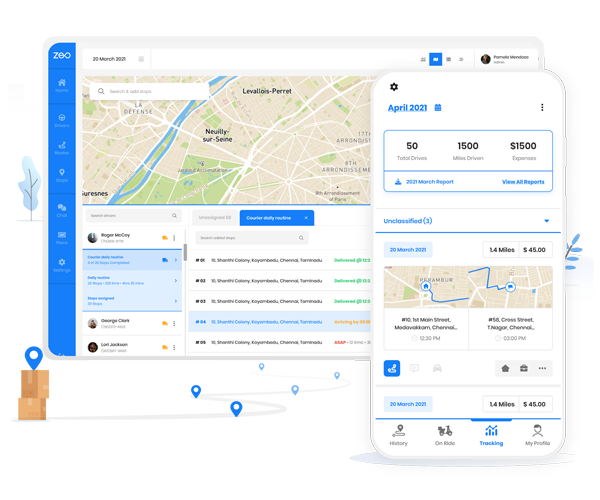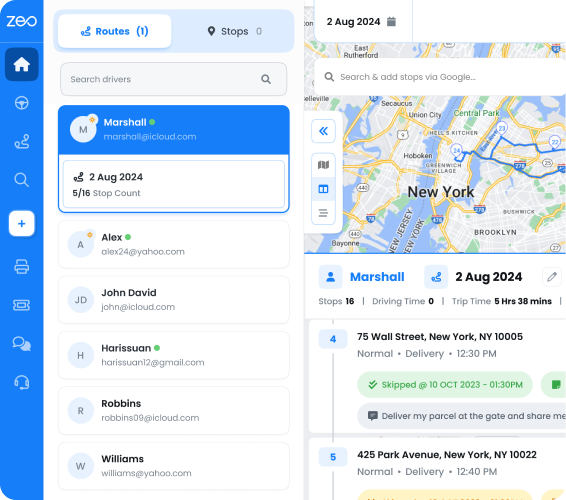Updated on: July 21, 2025
The world of fleet management is undergoing a rapid transformation, but are your fleet management processes evolving? Or are you still clinging to the traditional ways of managing your fleet?
New technologies and innovations are changing the way we approach route planning, vehicle management, and sustainability. Keeping up with the latest fleet management trends is vital for staying ahead of the competition. To succeed, fleet managers need to embrace these changes and adopt modern fleet management apps that streamline their operations and boost efficiency.
Top 10 Fleet Management Trends to Look Out For
Smart use of technology and innovation will lead the way in fleet management in the coming years. Let’s dive into the top 10 trends that will shape the future of fleet management in 2025.
-
AI-Powered Route Optimization
One of the most significant upcoming fleet management trends is the rise of AI-powered route optimization. AI-driven algorithms are becoming smarter, predicting traffic patterns, accidents, and even weather conditions to adjust routes in real-time. In 2025, this technology will evolve further, enabling fleets to avoid delays and reduce fuel consumption through smarter, more adaptive route planning. AI will take efficiency to a whole new level by making decisions faster than ever before.
What it Means for Fleet Management: AI will dramatically improve delivery times and minimize fuel costs, making fleet management apps an essential tool for keeping fleets running smoothly. It will allow fleet managers to make data-driven decisions on the go, leading to more precise route planning.
-
Integration with Smart City Infrastructure
As cities embrace smart technologies, fleet management will increasingly depend on integration with urban infrastructure. In the near future, fleets will interact directly with smart traffic lights, road sensors, and real-time congestion reports. Fleet vehicles will receive instant updates about road conditions, helping drivers avoid delays and maximize efficiency.
What it Means for Fleet Management: This integration will lead to faster, more efficient routes in urban areas, reducing congestion and fuel consumption. Fleet managers can use fleet management apps to optimize vehicle movement through smart city infrastructure, improving delivery times.
-
Increasing EV Adoption
One of the most talked-about fleet management trends is the rapid adoption of electric vehicles (EVs). As companies look to reduce their carbon footprints and comply with new regulations, the shift toward EVs is accelerating. By 2025, fleets will rely more heavily on electric vehicles due to lower operational costs and sustainability goals. Managing charging infrastructure and route planning for EVs will require advanced route planners for fleets that can monitor battery levels and charging locations in real-time.
What it Means for Fleet Management: Fleet managers will need to adjust their operations to include EV-specific routes, charging station management, and sustainability tracking. Fleet management apps will be indispensable for keeping EV fleets running efficiently and sustainably.
-
Predictive Maintenance with IoT Sensors
Preventive maintenance is becoming more advanced thanks to IoT sensors, and this will only grow in 2025. Vehicles equipped with sensors can transmit real-time data on engine performance, brake conditions, and other critical systems. With predictive maintenance, fleet managers can prevent costly breakdowns before they happen.
What it Means for Fleet Management: Predictive maintenance will significantly reduce vehicle downtime and maintenance costs. Fleet managers will benefit from real-time updates on vehicle health through their fleet management apps, ensuring a more reliable and cost-efficient fleet.
-
Route Planners with Real-Time Data Analytics
The power of real-time route analytics cannot be overstated, and this will be a major focus in 2025 and beyond. Modern route planners are evolving to provide instant insights into vehicle performance, driver behavior, and fuel consumption. With this data at their fingertips, fleet managers can make quick decisions that optimize routes, reduce fuel usage, and improve driver efficiency.
What it Means for Fleet Management: The ability to analyze data in real-time will give fleet managers a competitive edge, allowing them to respond to issues as they arise. Fleet management tools will become essential for monitoring performance metrics and enhancing fleet efficiency.
-
5G Connectivity for Fleets
As 5G networks continue to expand, fleet vehicles will benefit from faster and more reliable connectivity. This will enable real-time monitoring, enhanced communication between drivers and dispatchers, and faster updates from vehicles on the road. With 5G, fleet management tools will provide more responsive services, including real-time tracking, instant alerts, and dynamic route changes.
increase fuel savings
Save 2 Hours on Deliveries, Everyday!
Optimize routes with our algorithm, reducing travel time and costs efficiently.
Get Started for FreeWhat it Means for Fleet Management: 5G will improve operational efficiency by enabling faster communication and more accurate data collection. Fleet managers will rely on fleet management apps to harness the full potential of this high-speed connectivity.
-
Driver-Focused Telematics
Telematics systems focused on vehicle and driver well-being will become a critical component of fleet management in 2025. These systems will offer real-time feedback on driving habits, such as speeding or harsh braking, and provide recommendations for safer driving. As safety becomes a priority, driver-focused telematics will help reduce accidents and improve overall fleet performance.
What it Means for Fleet Management: Fleet managers will be able to monitor and improve driver behavior, resulting in safer driving practices and lower accident rates. Route planning software with telematics integration will make it easier to track and enhance driver performance.
-
Carbon Footprint Tracking
Sustainability will continue to dominate the list of fleet management trends in 2025. Tools that monitor carbon emissions will become essential as companies strive to reduce their environmental impact. Fleet management apps will integrate carbon tracking features, allowing businesses to measure and reduce their carbon footprint.
What it Means for Fleet Management: Carbon tracking will enable fleet managers to make eco-friendly decisions, improving their company’s sustainability profile. Using fleet management software, they can easily monitor emissions and take steps to reduce their carbon footprint.
-
Blockchain for Fleet Security
Blockchain technology is set to transform fleet security by offering secure, immutable records of fleet data. In 2025, this technology will be one of the leading fleet management trends, particularly useful for managing contracts, ensuring compliance, and protecting sensitive data. Route planning software with blockchain integration will help businesses ensure data integrity and secure fleet operations.
What it Means for Fleet Management: Blockchain will enhance security and transparency in fleet operations, reducing risks associated with data breaches and compliance issues. Fleet managers will trust fleet management apps to safeguard their fleet data.
-
Advanced Driver Assistance Systems (ADAS)
Advanced Driver Assistance Systems (ADAS) will become increasingly common fleet management trends in 2025. Technologies such as automatic braking, adaptive cruise control, lane-keeping assistance, and collision avoidance will improve driver safety and reduce the likelihood of accidents. The use of ADAS will boost fleet morale as they will understand their employer cares for their safety.
increase fuel savings
Save 2 Hours on Deliveries, Everyday!
Optimize routes with our algorithm, reducing travel time and costs efficiently.
Get Started for FreeWhat it Means for Fleet Management: ADAS will make fleet driving safer and reduce accident-related costs. Fleet managers will rely on fleet management apps to track and optimize the use of ADAS technologies.
Conclusion
The future of fleet management is brimming with innovation. Staying on top of these fleet management trends will help businesses remain competitive in a fast-changing environment. With modern fleet management apps, fleet managers can harness these trends to improve efficiency, sustainability, and security. They will increasingly switch to AI-powered route planners for fleet management.
One such route planner is Zeo. Zeo’s advanced and AI-powered fleet management solutions are designed to help you enhance operational efficiency. From AI-powered route optimization to real-time data analytics, Zeo offers future-driven functionalities to help you stay ahead of the curve.
Ready to future-proof your fleet? Get started with Zeo today and lead the charge into 2025.

Are you a fleet owner?
Want to manage your drivers and deliveries easily?
Grow your business effortlessly with Zeo Routes Planner – optimize routes and manage multiple drivers with ease.

increase fuel savings
Hassle Free Deliveries & Pickups!
Optimize routes with our algorithm, reducing travel time and costs efficiently.
Get Started for Free





















